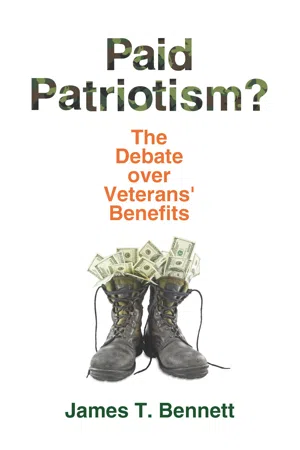Bonus Army
The Bonus Army was a group of World War I veterans who marched on Washington, D.C. in 1932 to demand immediate payment of a bonus that had been promised to them for their wartime service. The protest turned into a large encampment, which was forcibly dispersed by the U.S. Army under the command of General Douglas MacArthur, leading to public outcry and political repercussions.
5 Key excerpts on "Bonus Army"
- eBook - ePub
Paid Patriotism?
The Debate over Veterans' Benefits
- James T. Bennett(Author)
- 2017(Publication Date)
- Routledge(Publisher)
...Great Depression-wracked veterans marched on Washington in 1932 demanding immediate redemption of their certificates. When they failed to get satisfaction, they set up camps throughout the nation’s capital, which were demolished by troops under the command of General Douglas MacArthur. The Veterans of Foreign Wars, which had been a very distant rival to the American Legion, skillfully exploited the bonus issue into a remarkable revival. As World War II wound down, policymakers again learned from, or reacted to, the mistakes of the previous generation. The Bonus Marchers weighed heavily in their calculations, for as Warren H. Atherton, the national commander of the American Legion, warned in a May 1944 radio address, "Veterans will be a potent force for good or evil in the years to come. They can make our country or break it. They can restore our democracy or scrap it." 7 Translation: fork over the bennies or there'll be chaos in the streets. Even President Franklin D. Roosevelt, in a line that conjured images of destitute Bonus Marchers, cautioned that "People who are hungry and out of a job are the stuff of which dictatorships are made." 8 The implication? Feed them and put them to work before they start raising hell. To assist veterans of World War II, Congress, aided in no small part by the American Legion, fashioned the much-heralded Servicemen’s Readjustment Act of 1944, better known as the GI Bill of Rights. This act provided unemployment assistance, farm and home loans, and other benefits for returning soldiers. The most famous, indeed mythic, benefit was in the form of tuition-free education and living stipends. Recent scholarship has tempered some of the more outlandish claims of the GI Bill’s myth-making supporters...
- Jan Arminio, Tomoko Kudo Grabosky, Josh Lang(Authors)
- 2014(Publication Date)
- Routledge(Publisher)
...Veterans were distraught that their fellows in arms (current Army soldiers) would turn against them. Understanding the significant opposition to paying them the bonus by the American Legion, big business, and military leadership including Admiral Byrd (Ortiz, 2006), defeated, they returned home. At the time, the membership of the American Legion was dominated by business leaders whereas the members of the Veterans of Foreign Wars (VFW) were more working-class veterans. Consequently, the VFW was a strong supporter of the bonus. Not wanting the issue to die, the VFW instigated a media campaign (including hiring an artist and political cartoonist) to lobby for the Bonus Marchers’ position (Ortiz, 2006). Upon the election of Franklin Delano Roosevelt (FDR), the president moved quickly to pass the Economy Act of 1933 which drastically reduced federal compensation to veterans (Keene, 2001 ; Ortiz, 2006). This infuriated veterans who viewed FDR as a fellow veteran. Once again they felt betrayed so again they marched on Washington. Though in smaller numbers, they marched now with a more supportive general public and, due to fears of poor public relations, with a more sympathetic American Legion. FDR met with marchers and sent First Lady Eleanor to meet with them in their camp at Fort Hunt (Keene, 2001). Congress was now more supportive of the Great War veterans and by 1934 restored most of the previous veterans benefits. However, that included allowing veterans preference for jobs in the new Civilian Conservation Corp where they once again wore uniforms, were given orders, and were mandated to put a considerable amount of their pay into savings accounts (Keene, 2001). By 1936 (an election year), veterans were given their bonus and within “four months, over 98% of veterans had received full payment on their certificates” (Keene, 2001, p. 203). The plight of the Bonus Marchers highlights the differences in social class...
- eBook - ePub
US Defense Politics
The Origins of Security Policy
- Harvey M. Sapolsky, Harvey M. Sapolsky, Eugene Gholz, Caitlin Talmadge(Authors)
- 2017(Publication Date)
- Routledge(Publisher)
...There were also more wounded than in past wars, because medicine could save more of those hurt on the battlefield or stricken with disease than in the past. In 1921, Congress consolidated the programs providing veterans’ pensions and rehabilitative services into a separate Veterans Bureau, which also became responsible for a set of public hospitals that provided care for war-injured veterans. 17 p.229 Figure 13.1 Bonus Army shanties burning in sight of the US Capitol after the Army drove out the protestors Source: National Archives. The highest-profile political mobilization was about money, not health care. Veterans of the war had been sent home with a train ticket and $60, which many of them considered too little. In 1924, after much wrangling with the administration, Congress passed the World War Adjusted Compensation Act, which provided a complicated scheme of bonuses of up to $500 for stateside service and $625 for overseas service: the veterans would receive a certificate designating their bonus eligibility on their next birthday, but they would not be paid actual money until twenty years later, in 1945. Politicians were reluctant to provide a more generous benefit because of the high costs of Civil War benefits, accounting for at times a third of the federal budget. 18 Under the law, veterans could use their certificates as collateral for loans, and many did, but when the Great Depression hit in 1929, they clamored for immediate payment and additional awards. The government agreed to partial payment, but as the Depression deepened in 1932, veterans calling themselves the Bonus Army marched on Washington seeking full payment. Rebuffed, some set up makeshift encampments in an attempt to embarrass President Hoover and Congress into acting...
- eBook - ePub
US Defense Politics
The Origins of Security Policy
- Harvey M. Sapolsky, Eugene Gholz, Caitlin Talmadge(Authors)
- 2020(Publication Date)
- Routledge(Publisher)
...Veterans of the war had been sent home with a train ticket and $60, which many of them considered too little. In 1924, after much wrangling with the administration, Congress passed the World War Adjusted Compensation Act, which provided a complicated scheme of bonuses of up to $500 for stateside service and $625 for overseas service: the veterans would receive a certificate designating their bonus eligibility on their next birthday, but they would not be paid actual money until twenty years later, in 1945. Politicians were reluctant to provide a more generous benefit because of the high costs of Civil War benefits, accounting for at times a third of the federal budget. 25 Under the law, veterans could use their certificates as collateral for loans, and many did, but when the Great Depression hit in 1929, they clamored for immediate payment and additional awards. The government agreed to partial payment, but as the Depression deepened in 1932, veterans calling themselves the Bonus Army marched on Washington seeking full payment. Rebuffed, some set up makeshift encampments in an attempt to embarrass President Hoover and Congress into acting. After clashes with police and fears that unsanitary conditions in the encampments were creating a public health hazard, troops with armored vehicles and horses were called out to clear the city of the petitioning veterans and burn their shanty towns. Public sentiment shifted decidedly toward the veterans because of this use of force. 26 President Franklin Roosevelt’s New Deal, his response to the Depression, and World War II vastly expanded the federal role in American life. The president and his mostly supportive Congress were not about to disappoint the millions of new veterans the war was creating, having learned from Hoover’s Bonus Army experience...
- eBook - ePub
The Laws That Shaped America
Fifteen Acts of Congress and Their Lasting Impact
- Dennis W. Johnson(Author)
- 2009(Publication Date)
- Routledge(Publisher)
...Senator J. W. Elmer Thomas (Democrat–Oklahoma), a chief sponsor of the bill, was hopeful that the Senate would accept it, but, on June 14, the upper body resoundingly rejected the bonus bill, 62–18. In early June 1932, with the arrival of the Bonus Army, Congress and Hoover secretly sought to give the demonstrators army cots, blankets, tents, food, and medical supplies; the U.S. Army, however, protested, telling Congress that such gestures would violate the “basic principles” of the Army and the War Department toward this motley so-called Bonus Expeditionary Force. 31 In June 1932, General Douglas MacArthur, Army chief of staff, wired all corps area commanders that, if any Bonus Army marchers came through their areas, the commanders were to determine if any communists were present. MacArthur added that he wanted the names of those with “known communist leanings.” 32 In early July 1932 Congress appropriated funds to help veterans return to their homes; many of the estimated 12,000 veterans in Washington left for home. Congress adjourned for the year on July 16, without passing a bonus bill. 33 On July 21, with 5,000 veterans still in Washington, members of the Bonus Expeditionary Force were informed that they were to be evicted from a government-owned building on Pennsylvania Avenue. The warning was reiterated on July 27, and eviction began the next morning. One building was cleared, but then a fight broke out between 200 marchers and city police, and two marchers were killed. By that afternoon, the District Commissioners reported to President Hoover that the situation was out of control. Hoover, waiting an hour for the request to come in writing, then ordered MacArthur to clear the area. Federal cavalry, six tanks, and a column of infantry were called in...




